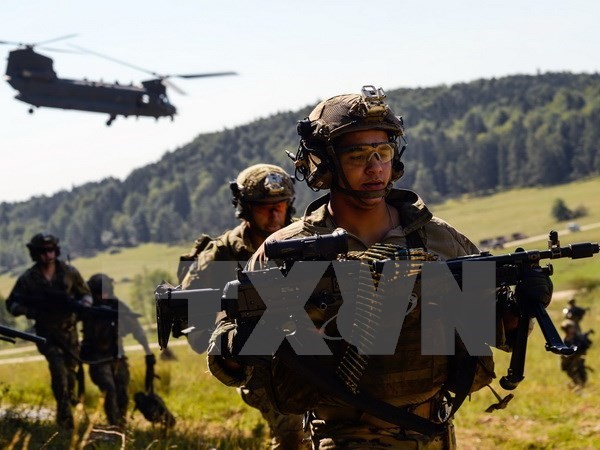(VOVworld) – The arms race between NATO and Russia has escalated since the UK announced its deployment of an additional 800 troops and fighter aircraft to Russia’s western border. Earlier, a Russian aircraft carrier approached the coast of several NATO members. The escalating tension is threatening Europe’s stability.
 |
| A NATO miliatry excercise in Hohenfels, southern Germany (Photo: AFP/VNA) |
Since the NATO summit in July, there has been no positive sign in Russia-NATO relations.
NATO beefs up security
The UK said its 800 troops equipped with tanks and unmanned planes will be sent to Estonia early next year in to honor NATO’s commitment to protect the Baltic nations. The number of troops is 300 more than the number announced earlier this year and will be the longest deployment of UK troops to one of Russia’s neighbors since the end of the Cold War. According to the UK Ministry of Defense, British troops will be stationed at Tapa military base for 6 months. The 4 battalions are mobilized to counter a perceived Russian threat to NATO’ eastern allies as Russian warships sailed towards Syria presumably to attack targets in Aleppo.
NATO’s military build-up has provoked a strong backlash from Moscow. On October 31, Aleksander Grushko, the Russian permanent representative to NATO, said Moscow will not ignore these acts and warned of retaliatory measures. Mr. Grushko said that what the UK has called “strengthening the security of allies” is actually causing security to deteriorate. According to the Russian diplomat, the 1997 Russia-NATO Pact bans NATO from sending significant forces to Russia’s border.
At a summit in Warsaw in July, NATO voted to increase its eastern border strength by deploying 4 battalions of 4,000 troops on a rotating basis to Poland and the 3 Baltic countries: Estonia, Latvia, and Lithuania. The UK, Canada, Germany, and the US agreed to assume a primary role and the rest of the 24 NATO members will contribute transportation, communications, and medical support.
Armament threat
Observers says NATO’s latest mobilization is the biggest troop mobilization since the Cold War. But NATO Secretary General Jens Stoltenberg denied any intention of confronting Russia, saying NATO does not want an arms race and is merely defending itself. Russia is not persuaded by NATO’s explanation and considers NATO’s move provocative and threatening to Russia’s security.
Moscow has an ace up its sleeve: Kaliningrad province situated in the heart of Europe, where in early October Moscow deployed its Iskander ballistic missile system, which has a range of over 500km and is capable of carrying nuclear warheads. Russia has sent 8 aircraft carriers through the Channel that separates southern England from northern France. The Russian army regularly conducts large-scale exercises near Russia’s border with NATO. Hundreds of troops and military equipment have been involved in exercises that Moscow says are aimed at checking combat readiness in case of an emergency.
The relationship between NATO and Russia has deteriorated since Russia’s annexation of Crimea. Observers say if Russia suffers economic losses from its stalled cooperation with the West, NATO security will suffer as will its war against terrorists in Afghanistan and the Middle East, particularly IS.